Swinburne INF20003 Assignment 1: RTGM Requirements and Analysis Report
VerifiedAdded on 2022/08/24
|22
|3356
|15
Report
AI Summary
This report, prepared for INF20003 at Swinburne University, analyzes the stakeholders and requirements of a real-time glucose monitoring (RTGM) system developed by DigiHealth medical Services. The report identifies functional and non-functional requirements, analyzes the needs of stakeholders including patients, medical professionals, government, and MyHealth Medical Center, and compares these needs with DigiHealth's objectives. It includes a requirement analysis based on quantitative and qualitative surveys, and an activity diagram illustrating the information flow. The report details parameters for alerting patients based on glucose levels, and provides data on RTGM usage and outcomes. It also outlines potential non-functional requirements such as data security and user-friendly interfaces. The report also explores the future development of wearable healthcare devices. The report includes a context diagram, data flow diagrams, and an entity-relationship diagram to illustrate the system's design and data structure.
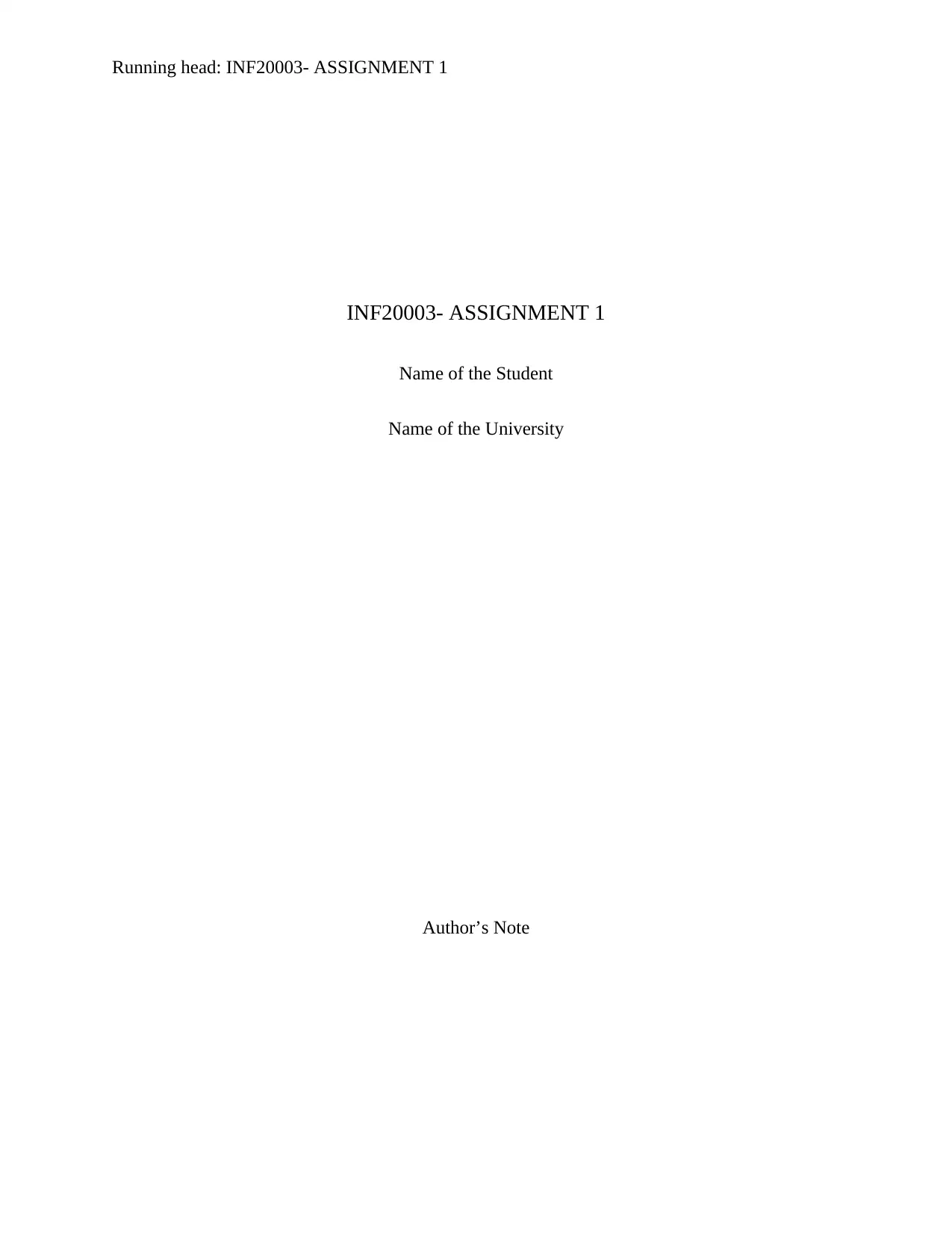
Running head: INF20003- ASSIGNMENT 1
INF20003- ASSIGNMENT 1
Name of the Student
Name of the University
Author’s Note
INF20003- ASSIGNMENT 1
Name of the Student
Name of the University
Author’s Note
Paraphrase This Document
Need a fresh take? Get an instant paraphrase of this document with our AI Paraphraser
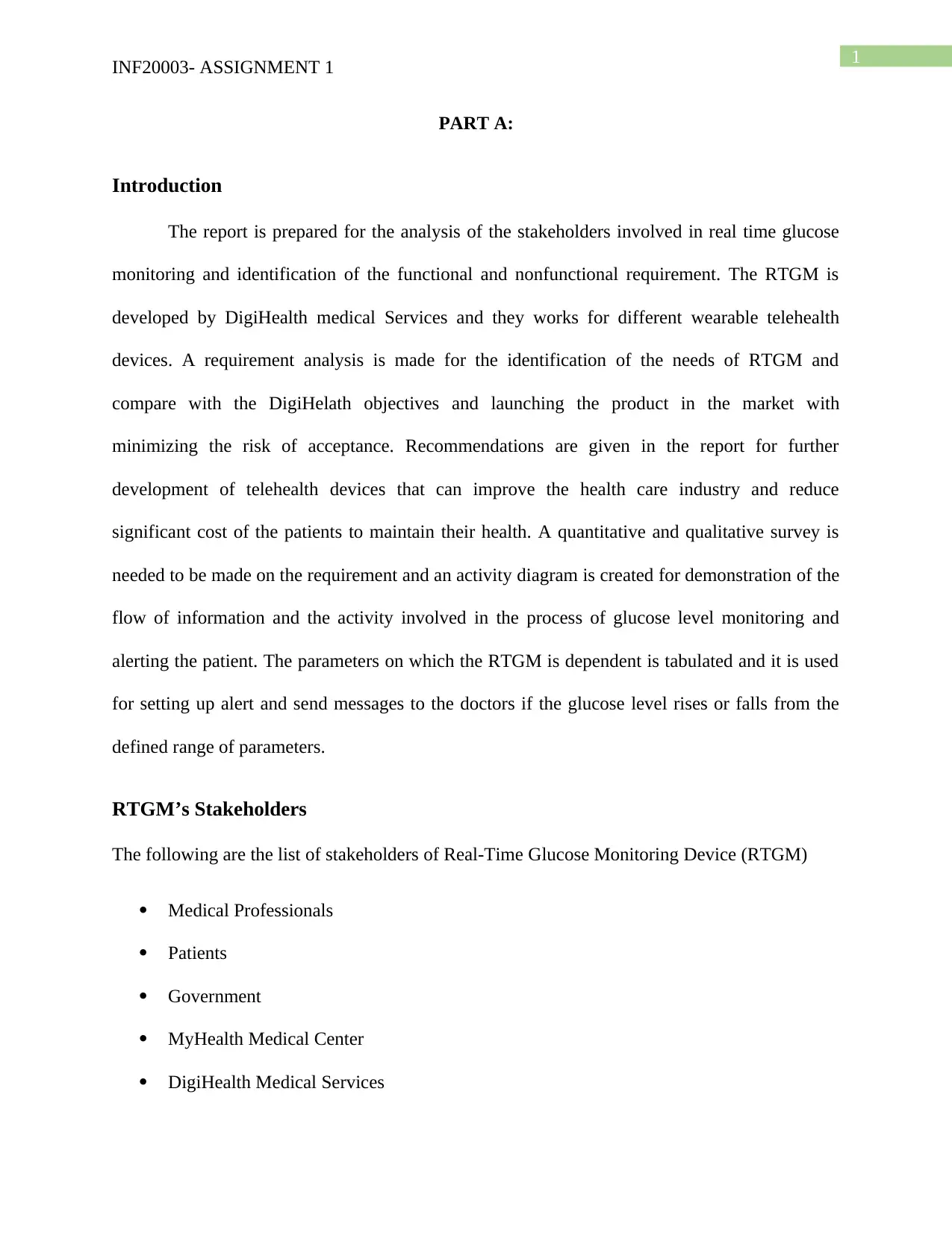
1
INF20003- ASSIGNMENT 1
PART A:
Introduction
The report is prepared for the analysis of the stakeholders involved in real time glucose
monitoring and identification of the functional and nonfunctional requirement. The RTGM is
developed by DigiHealth medical Services and they works for different wearable telehealth
devices. A requirement analysis is made for the identification of the needs of RTGM and
compare with the DigiHelath objectives and launching the product in the market with
minimizing the risk of acceptance. Recommendations are given in the report for further
development of telehealth devices that can improve the health care industry and reduce
significant cost of the patients to maintain their health. A quantitative and qualitative survey is
needed to be made on the requirement and an activity diagram is created for demonstration of the
flow of information and the activity involved in the process of glucose level monitoring and
alerting the patient. The parameters on which the RTGM is dependent is tabulated and it is used
for setting up alert and send messages to the doctors if the glucose level rises or falls from the
defined range of parameters.
RTGM’s Stakeholders
The following are the list of stakeholders of Real-Time Glucose Monitoring Device (RTGM)
Medical Professionals
Patients
Government
MyHealth Medical Center
DigiHealth Medical Services
INF20003- ASSIGNMENT 1
PART A:
Introduction
The report is prepared for the analysis of the stakeholders involved in real time glucose
monitoring and identification of the functional and nonfunctional requirement. The RTGM is
developed by DigiHealth medical Services and they works for different wearable telehealth
devices. A requirement analysis is made for the identification of the needs of RTGM and
compare with the DigiHelath objectives and launching the product in the market with
minimizing the risk of acceptance. Recommendations are given in the report for further
development of telehealth devices that can improve the health care industry and reduce
significant cost of the patients to maintain their health. A quantitative and qualitative survey is
needed to be made on the requirement and an activity diagram is created for demonstration of the
flow of information and the activity involved in the process of glucose level monitoring and
alerting the patient. The parameters on which the RTGM is dependent is tabulated and it is used
for setting up alert and send messages to the doctors if the glucose level rises or falls from the
defined range of parameters.
RTGM’s Stakeholders
The following are the list of stakeholders of Real-Time Glucose Monitoring Device (RTGM)
Medical Professionals
Patients
Government
MyHealth Medical Center
DigiHealth Medical Services
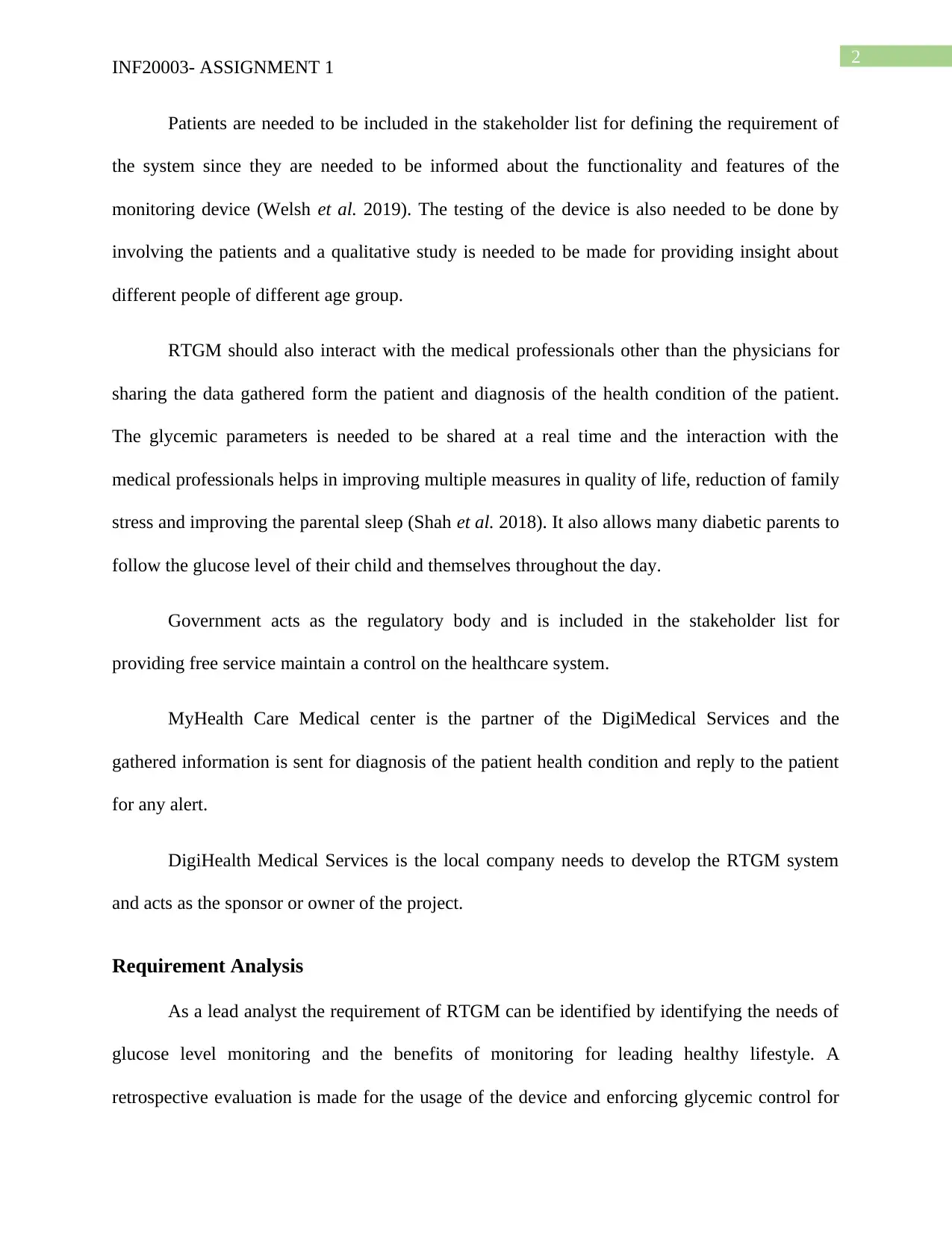
2
INF20003- ASSIGNMENT 1
Patients are needed to be included in the stakeholder list for defining the requirement of
the system since they are needed to be informed about the functionality and features of the
monitoring device (Welsh et al. 2019). The testing of the device is also needed to be done by
involving the patients and a qualitative study is needed to be made for providing insight about
different people of different age group.
RTGM should also interact with the medical professionals other than the physicians for
sharing the data gathered form the patient and diagnosis of the health condition of the patient.
The glycemic parameters is needed to be shared at a real time and the interaction with the
medical professionals helps in improving multiple measures in quality of life, reduction of family
stress and improving the parental sleep (Shah et al. 2018). It also allows many diabetic parents to
follow the glucose level of their child and themselves throughout the day.
Government acts as the regulatory body and is included in the stakeholder list for
providing free service maintain a control on the healthcare system.
MyHealth Care Medical center is the partner of the DigiMedical Services and the
gathered information is sent for diagnosis of the patient health condition and reply to the patient
for any alert.
DigiHealth Medical Services is the local company needs to develop the RTGM system
and acts as the sponsor or owner of the project.
Requirement Analysis
As a lead analyst the requirement of RTGM can be identified by identifying the needs of
glucose level monitoring and the benefits of monitoring for leading healthy lifestyle. A
retrospective evaluation is made for the usage of the device and enforcing glycemic control for
INF20003- ASSIGNMENT 1
Patients are needed to be included in the stakeholder list for defining the requirement of
the system since they are needed to be informed about the functionality and features of the
monitoring device (Welsh et al. 2019). The testing of the device is also needed to be done by
involving the patients and a qualitative study is needed to be made for providing insight about
different people of different age group.
RTGM should also interact with the medical professionals other than the physicians for
sharing the data gathered form the patient and diagnosis of the health condition of the patient.
The glycemic parameters is needed to be shared at a real time and the interaction with the
medical professionals helps in improving multiple measures in quality of life, reduction of family
stress and improving the parental sleep (Shah et al. 2018). It also allows many diabetic parents to
follow the glucose level of their child and themselves throughout the day.
Government acts as the regulatory body and is included in the stakeholder list for
providing free service maintain a control on the healthcare system.
MyHealth Care Medical center is the partner of the DigiMedical Services and the
gathered information is sent for diagnosis of the patient health condition and reply to the patient
for any alert.
DigiHealth Medical Services is the local company needs to develop the RTGM system
and acts as the sponsor or owner of the project.
Requirement Analysis
As a lead analyst the requirement of RTGM can be identified by identifying the needs of
glucose level monitoring and the benefits of monitoring for leading healthy lifestyle. A
retrospective evaluation is made for the usage of the device and enforcing glycemic control for
⊘ This is a preview!⊘
Do you want full access?
Subscribe today to unlock all pages.

Trusted by 1+ million students worldwide
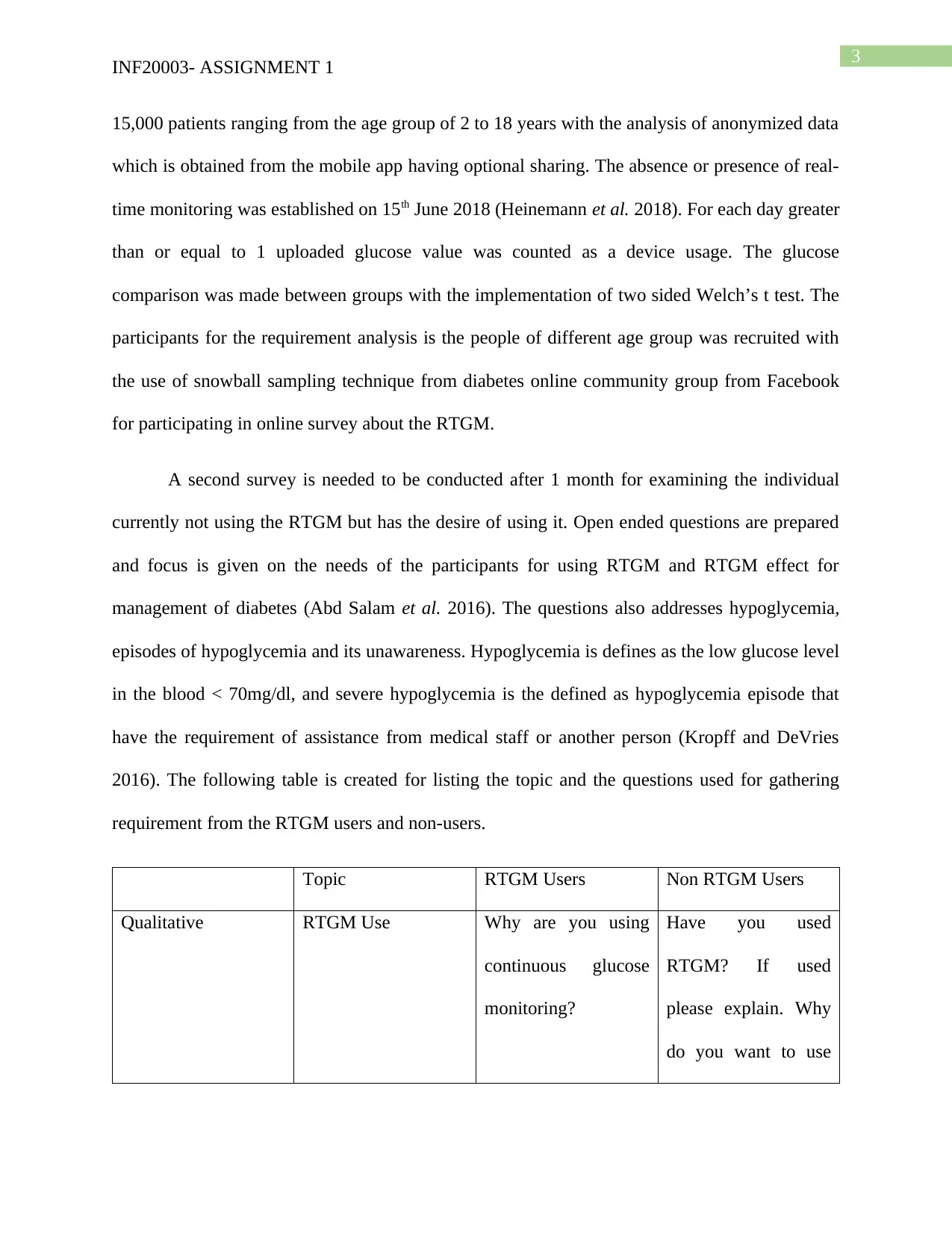
3
INF20003- ASSIGNMENT 1
15,000 patients ranging from the age group of 2 to 18 years with the analysis of anonymized data
which is obtained from the mobile app having optional sharing. The absence or presence of real-
time monitoring was established on 15th June 2018 (Heinemann et al. 2018). For each day greater
than or equal to 1 uploaded glucose value was counted as a device usage. The glucose
comparison was made between groups with the implementation of two sided Welch’s t test. The
participants for the requirement analysis is the people of different age group was recruited with
the use of snowball sampling technique from diabetes online community group from Facebook
for participating in online survey about the RTGM.
A second survey is needed to be conducted after 1 month for examining the individual
currently not using the RTGM but has the desire of using it. Open ended questions are prepared
and focus is given on the needs of the participants for using RTGM and RTGM effect for
management of diabetes (Abd Salam et al. 2016). The questions also addresses hypoglycemia,
episodes of hypoglycemia and its unawareness. Hypoglycemia is defines as the low glucose level
in the blood < 70mg/dl, and severe hypoglycemia is the defined as hypoglycemia episode that
have the requirement of assistance from medical staff or another person (Kropff and DeVries
2016). The following table is created for listing the topic and the questions used for gathering
requirement from the RTGM users and non-users.
Topic RTGM Users Non RTGM Users
Qualitative RTGM Use Why are you using
continuous glucose
monitoring?
Have you used
RTGM? If used
please explain. Why
do you want to use
INF20003- ASSIGNMENT 1
15,000 patients ranging from the age group of 2 to 18 years with the analysis of anonymized data
which is obtained from the mobile app having optional sharing. The absence or presence of real-
time monitoring was established on 15th June 2018 (Heinemann et al. 2018). For each day greater
than or equal to 1 uploaded glucose value was counted as a device usage. The glucose
comparison was made between groups with the implementation of two sided Welch’s t test. The
participants for the requirement analysis is the people of different age group was recruited with
the use of snowball sampling technique from diabetes online community group from Facebook
for participating in online survey about the RTGM.
A second survey is needed to be conducted after 1 month for examining the individual
currently not using the RTGM but has the desire of using it. Open ended questions are prepared
and focus is given on the needs of the participants for using RTGM and RTGM effect for
management of diabetes (Abd Salam et al. 2016). The questions also addresses hypoglycemia,
episodes of hypoglycemia and its unawareness. Hypoglycemia is defines as the low glucose level
in the blood < 70mg/dl, and severe hypoglycemia is the defined as hypoglycemia episode that
have the requirement of assistance from medical staff or another person (Kropff and DeVries
2016). The following table is created for listing the topic and the questions used for gathering
requirement from the RTGM users and non-users.
Topic RTGM Users Non RTGM Users
Qualitative RTGM Use Why are you using
continuous glucose
monitoring?
Have you used
RTGM? If used
please explain. Why
do you want to use
Paraphrase This Document
Need a fresh take? Get an instant paraphrase of this document with our AI Paraphraser
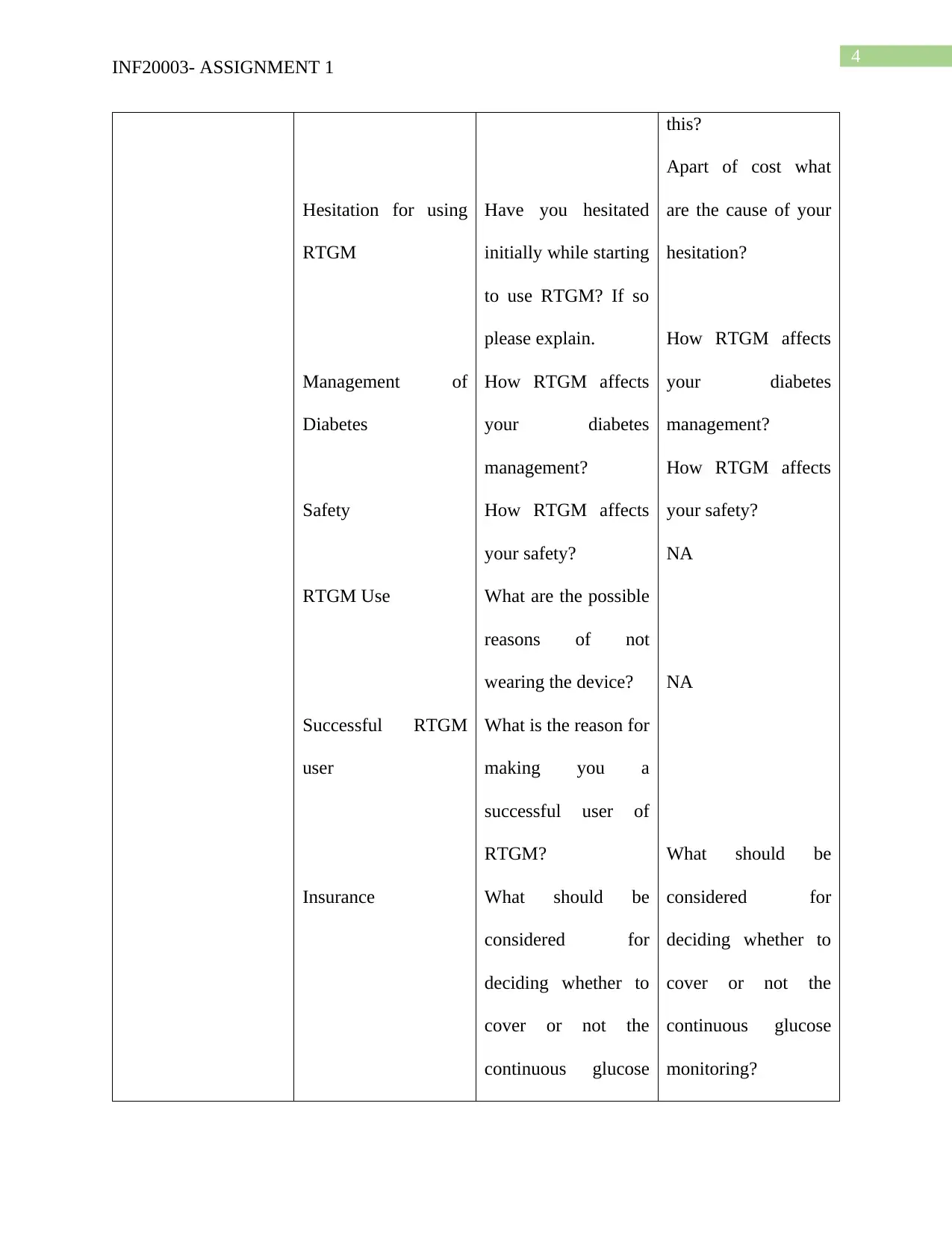
4
INF20003- ASSIGNMENT 1
Hesitation for using
RTGM
Management of
Diabetes
Safety
RTGM Use
Successful RTGM
user
Insurance
Have you hesitated
initially while starting
to use RTGM? If so
please explain.
How RTGM affects
your diabetes
management?
How RTGM affects
your safety?
What are the possible
reasons of not
wearing the device?
What is the reason for
making you a
successful user of
RTGM?
What should be
considered for
deciding whether to
cover or not the
continuous glucose
this?
Apart of cost what
are the cause of your
hesitation?
How RTGM affects
your diabetes
management?
How RTGM affects
your safety?
NA
NA
What should be
considered for
deciding whether to
cover or not the
continuous glucose
monitoring?
INF20003- ASSIGNMENT 1
Hesitation for using
RTGM
Management of
Diabetes
Safety
RTGM Use
Successful RTGM
user
Insurance
Have you hesitated
initially while starting
to use RTGM? If so
please explain.
How RTGM affects
your diabetes
management?
How RTGM affects
your safety?
What are the possible
reasons of not
wearing the device?
What is the reason for
making you a
successful user of
RTGM?
What should be
considered for
deciding whether to
cover or not the
continuous glucose
this?
Apart of cost what
are the cause of your
hesitation?
How RTGM affects
your diabetes
management?
How RTGM affects
your safety?
NA
NA
What should be
considered for
deciding whether to
cover or not the
continuous glucose
monitoring?
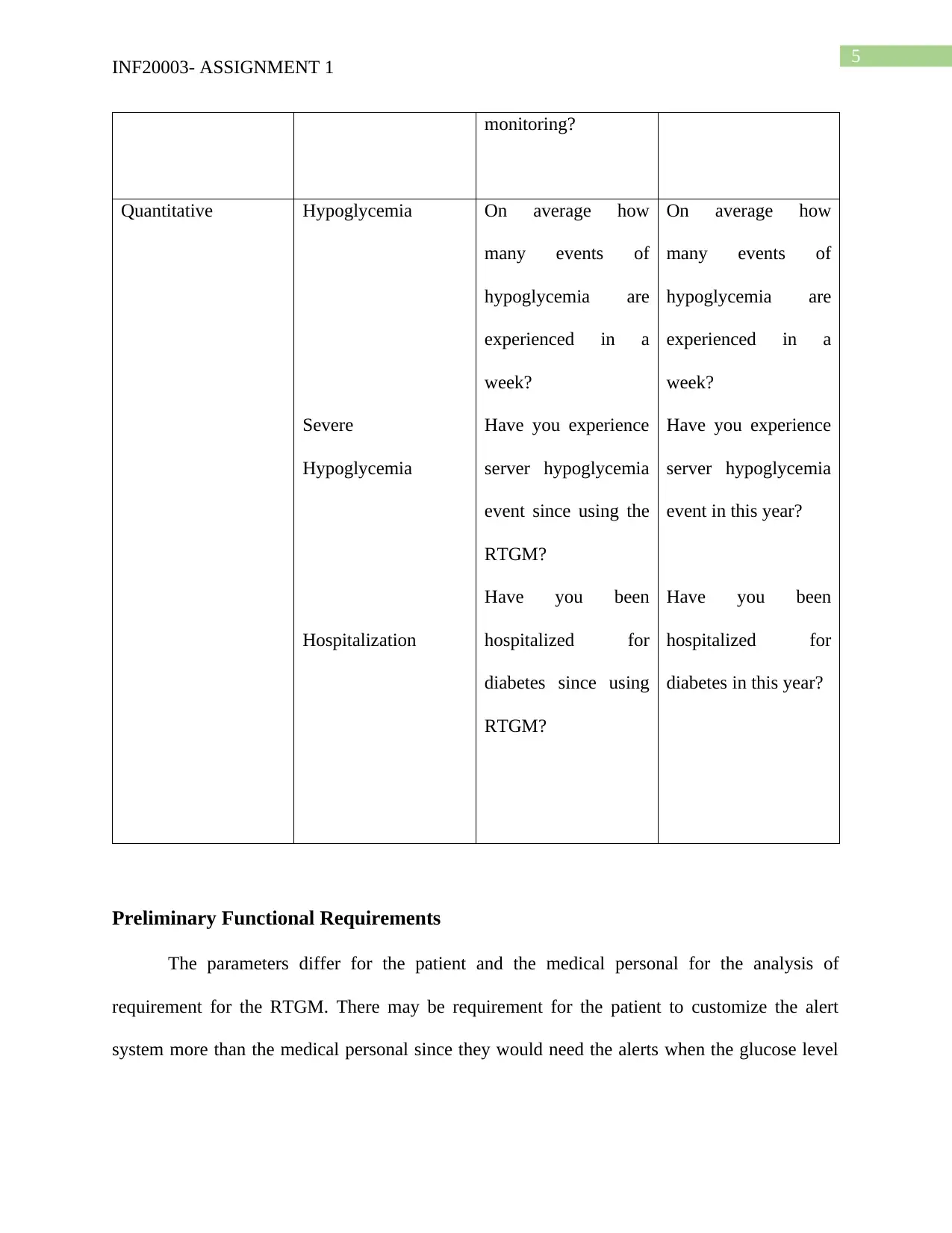
5
INF20003- ASSIGNMENT 1
monitoring?
Quantitative Hypoglycemia
Severe
Hypoglycemia
Hospitalization
On average how
many events of
hypoglycemia are
experienced in a
week?
Have you experience
server hypoglycemia
event since using the
RTGM?
Have you been
hospitalized for
diabetes since using
RTGM?
On average how
many events of
hypoglycemia are
experienced in a
week?
Have you experience
server hypoglycemia
event in this year?
Have you been
hospitalized for
diabetes in this year?
Preliminary Functional Requirements
The parameters differ for the patient and the medical personal for the analysis of
requirement for the RTGM. There may be requirement for the patient to customize the alert
system more than the medical personal since they would need the alerts when the glucose level
INF20003- ASSIGNMENT 1
monitoring?
Quantitative Hypoglycemia
Severe
Hypoglycemia
Hospitalization
On average how
many events of
hypoglycemia are
experienced in a
week?
Have you experience
server hypoglycemia
event since using the
RTGM?
Have you been
hospitalized for
diabetes since using
RTGM?
On average how
many events of
hypoglycemia are
experienced in a
week?
Have you experience
server hypoglycemia
event in this year?
Have you been
hospitalized for
diabetes in this year?
Preliminary Functional Requirements
The parameters differ for the patient and the medical personal for the analysis of
requirement for the RTGM. There may be requirement for the patient to customize the alert
system more than the medical personal since they would need the alerts when the glucose level
⊘ This is a preview!⊘
Do you want full access?
Subscribe today to unlock all pages.

Trusted by 1+ million students worldwide
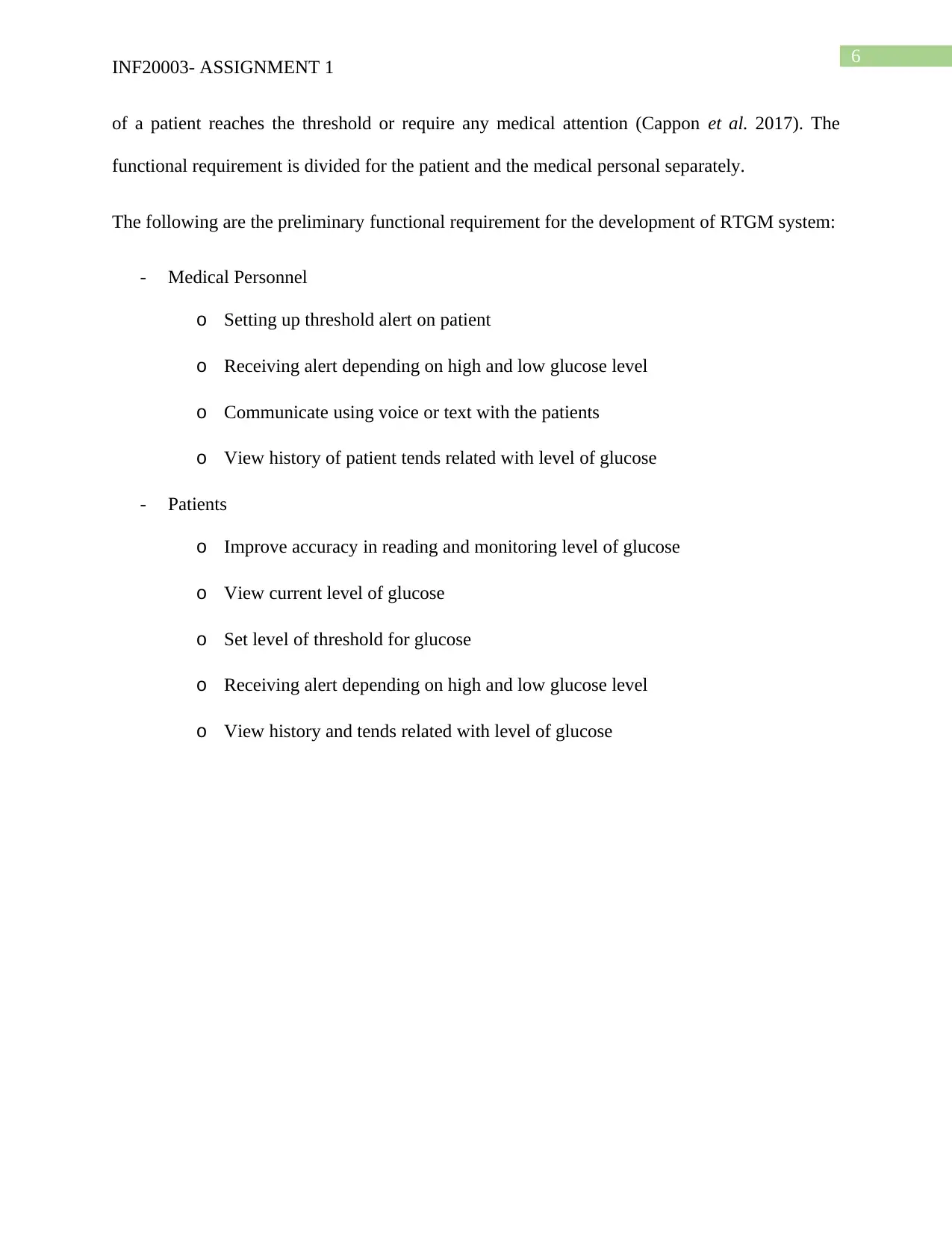
6
INF20003- ASSIGNMENT 1
of a patient reaches the threshold or require any medical attention (Cappon et al. 2017). The
functional requirement is divided for the patient and the medical personal separately.
The following are the preliminary functional requirement for the development of RTGM system:
- Medical Personnel
o Setting up threshold alert on patient
o Receiving alert depending on high and low glucose level
o Communicate using voice or text with the patients
o View history of patient tends related with level of glucose
- Patients
o Improve accuracy in reading and monitoring level of glucose
o View current level of glucose
o Set level of threshold for glucose
o Receiving alert depending on high and low glucose level
o View history and tends related with level of glucose
INF20003- ASSIGNMENT 1
of a patient reaches the threshold or require any medical attention (Cappon et al. 2017). The
functional requirement is divided for the patient and the medical personal separately.
The following are the preliminary functional requirement for the development of RTGM system:
- Medical Personnel
o Setting up threshold alert on patient
o Receiving alert depending on high and low glucose level
o Communicate using voice or text with the patients
o View history of patient tends related with level of glucose
- Patients
o Improve accuracy in reading and monitoring level of glucose
o View current level of glucose
o Set level of threshold for glucose
o Receiving alert depending on high and low glucose level
o View history and tends related with level of glucose
Paraphrase This Document
Need a fresh take? Get an instant paraphrase of this document with our AI Paraphraser
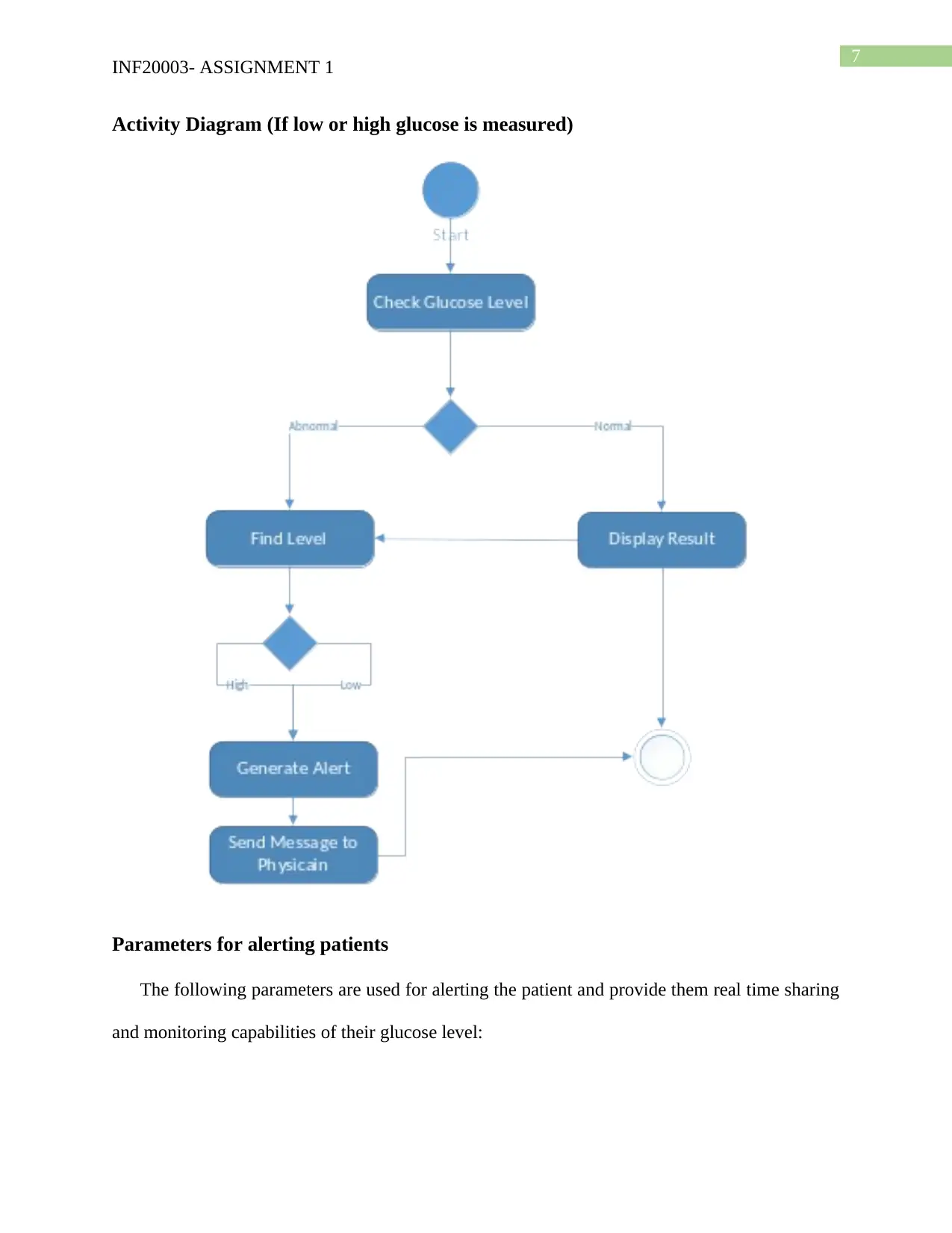
7
INF20003- ASSIGNMENT 1
Activity Diagram (If low or high glucose is measured)
Parameters for alerting patients
The following parameters are used for alerting the patient and provide them real time sharing
and monitoring capabilities of their glucose level:
INF20003- ASSIGNMENT 1
Activity Diagram (If low or high glucose is measured)
Parameters for alerting patients
The following parameters are used for alerting the patient and provide them real time sharing
and monitoring capabilities of their glucose level:
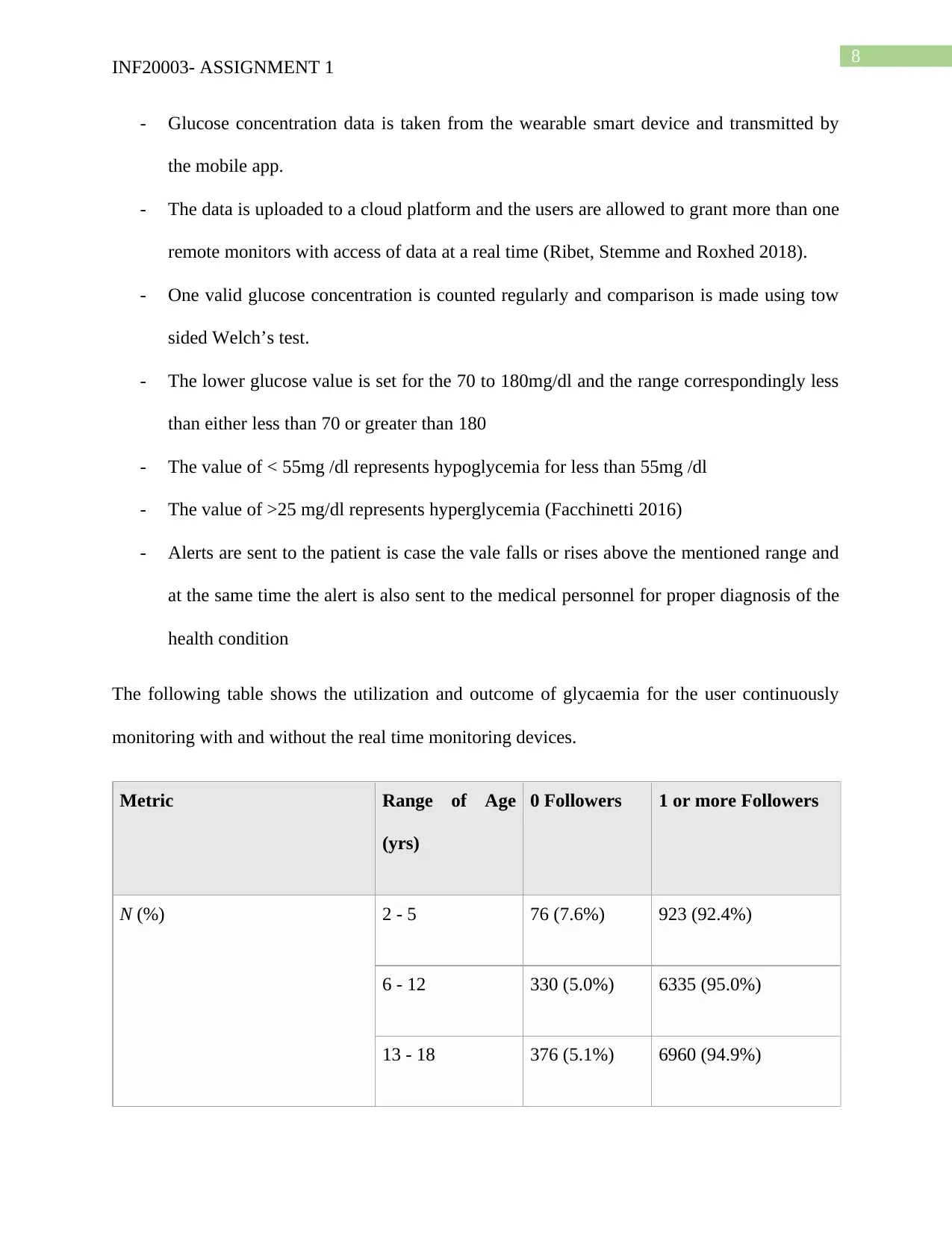
8
INF20003- ASSIGNMENT 1
- Glucose concentration data is taken from the wearable smart device and transmitted by
the mobile app.
- The data is uploaded to a cloud platform and the users are allowed to grant more than one
remote monitors with access of data at a real time (Ribet, Stemme and Roxhed 2018).
- One valid glucose concentration is counted regularly and comparison is made using tow
sided Welch’s test.
- The lower glucose value is set for the 70 to 180mg/dl and the range correspondingly less
than either less than 70 or greater than 180
- The value of < 55mg /dl represents hypoglycemia for less than 55mg /dl
- The value of >25 mg/dl represents hyperglycemia (Facchinetti 2016)
- Alerts are sent to the patient is case the vale falls or rises above the mentioned range and
at the same time the alert is also sent to the medical personnel for proper diagnosis of the
health condition
The following table shows the utilization and outcome of glycaemia for the user continuously
monitoring with and without the real time monitoring devices.
Metric Range of Age
(yrs)
0 Followers 1 or more Followers
N (%) 2 - 5 76 (7.6%) 923 (92.4%)
6 - 12 330 (5.0%) 6335 (95.0%)
13 - 18 376 (5.1%) 6960 (94.9%)
INF20003- ASSIGNMENT 1
- Glucose concentration data is taken from the wearable smart device and transmitted by
the mobile app.
- The data is uploaded to a cloud platform and the users are allowed to grant more than one
remote monitors with access of data at a real time (Ribet, Stemme and Roxhed 2018).
- One valid glucose concentration is counted regularly and comparison is made using tow
sided Welch’s test.
- The lower glucose value is set for the 70 to 180mg/dl and the range correspondingly less
than either less than 70 or greater than 180
- The value of < 55mg /dl represents hypoglycemia for less than 55mg /dl
- The value of >25 mg/dl represents hyperglycemia (Facchinetti 2016)
- Alerts are sent to the patient is case the vale falls or rises above the mentioned range and
at the same time the alert is also sent to the medical personnel for proper diagnosis of the
health condition
The following table shows the utilization and outcome of glycaemia for the user continuously
monitoring with and without the real time monitoring devices.
Metric Range of Age
(yrs)
0 Followers 1 or more Followers
N (%) 2 - 5 76 (7.6%) 923 (92.4%)
6 - 12 330 (5.0%) 6335 (95.0%)
13 - 18 376 (5.1%) 6960 (94.9%)
⊘ This is a preview!⊘
Do you want full access?
Subscribe today to unlock all pages.

Trusted by 1+ million students worldwide
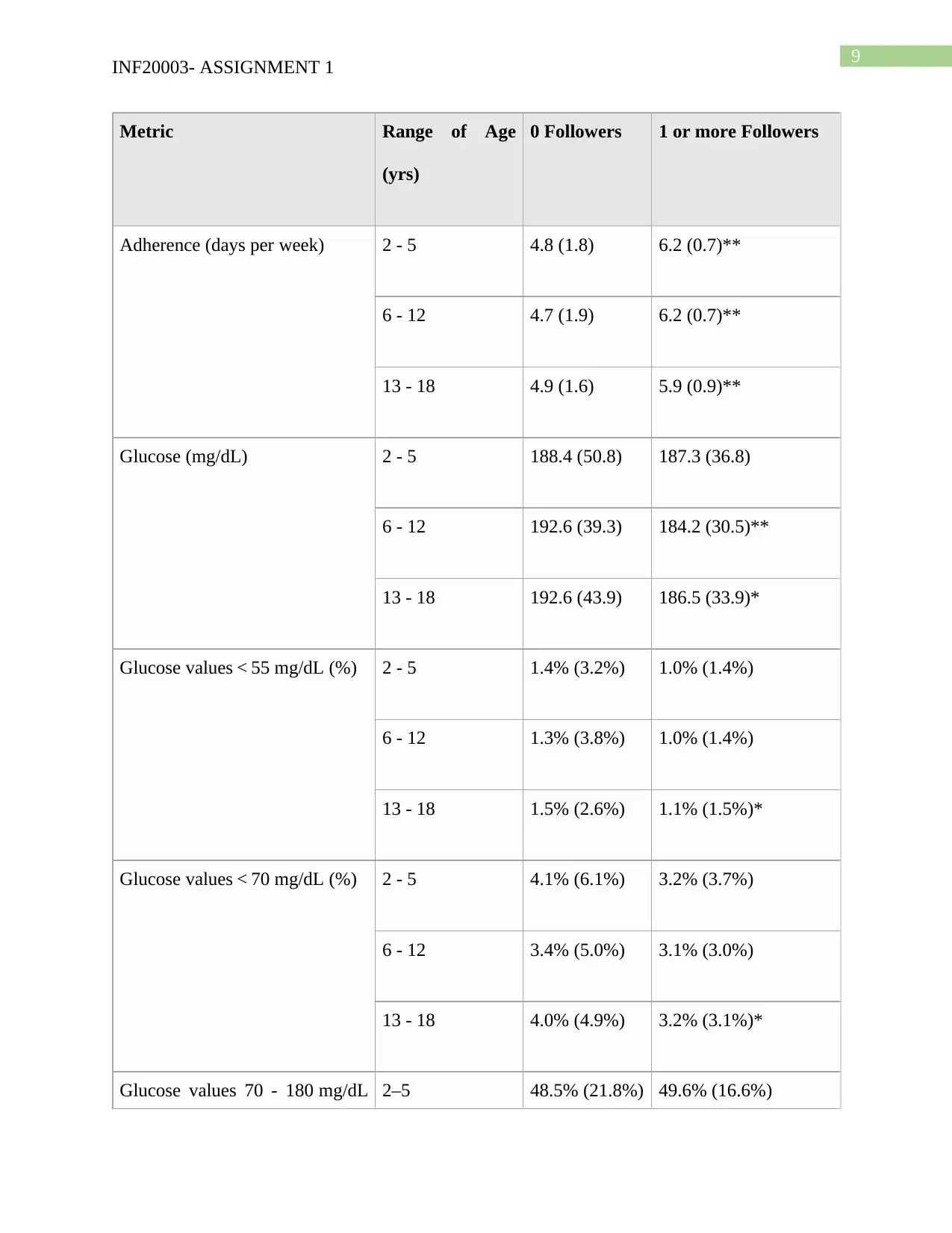
9
INF20003- ASSIGNMENT 1
Metric Range of Age
(yrs)
0 Followers 1 or more Followers
Adherence (days per week) 2 - 5 4.8 (1.8) 6.2 (0.7)**
6 - 12 4.7 (1.9) 6.2 (0.7)**
13 - 18 4.9 (1.6) 5.9 (0.9)**
Glucose (mg/dL) 2 - 5 188.4 (50.8) 187.3 (36.8)
6 - 12 192.6 (39.3) 184.2 (30.5)**
13 - 18 192.6 (43.9) 186.5 (33.9)*
Glucose values < 55 mg/dL (%) 2 - 5 1.4% (3.2%) 1.0% (1.4%)
6 - 12 1.3% (3.8%) 1.0% (1.4%)
13 - 18 1.5% (2.6%) 1.1% (1.5%)*
Glucose values < 70 mg/dL (%) 2 - 5 4.1% (6.1%) 3.2% (3.7%)
6 - 12 3.4% (5.0%) 3.1% (3.0%)
13 - 18 4.0% (4.9%) 3.2% (3.1%)*
Glucose values 70 - 180 mg/dL 2–5 48.5% (21.8%) 49.6% (16.6%)
INF20003- ASSIGNMENT 1
Metric Range of Age
(yrs)
0 Followers 1 or more Followers
Adherence (days per week) 2 - 5 4.8 (1.8) 6.2 (0.7)**
6 - 12 4.7 (1.9) 6.2 (0.7)**
13 - 18 4.9 (1.6) 5.9 (0.9)**
Glucose (mg/dL) 2 - 5 188.4 (50.8) 187.3 (36.8)
6 - 12 192.6 (39.3) 184.2 (30.5)**
13 - 18 192.6 (43.9) 186.5 (33.9)*
Glucose values < 55 mg/dL (%) 2 - 5 1.4% (3.2%) 1.0% (1.4%)
6 - 12 1.3% (3.8%) 1.0% (1.4%)
13 - 18 1.5% (2.6%) 1.1% (1.5%)*
Glucose values < 70 mg/dL (%) 2 - 5 4.1% (6.1%) 3.2% (3.7%)
6 - 12 3.4% (5.0%) 3.1% (3.0%)
13 - 18 4.0% (4.9%) 3.2% (3.1%)*
Glucose values 70 - 180 mg/dL 2–5 48.5% (21.8%) 49.6% (16.6%)
Paraphrase This Document
Need a fresh take? Get an instant paraphrase of this document with our AI Paraphraser
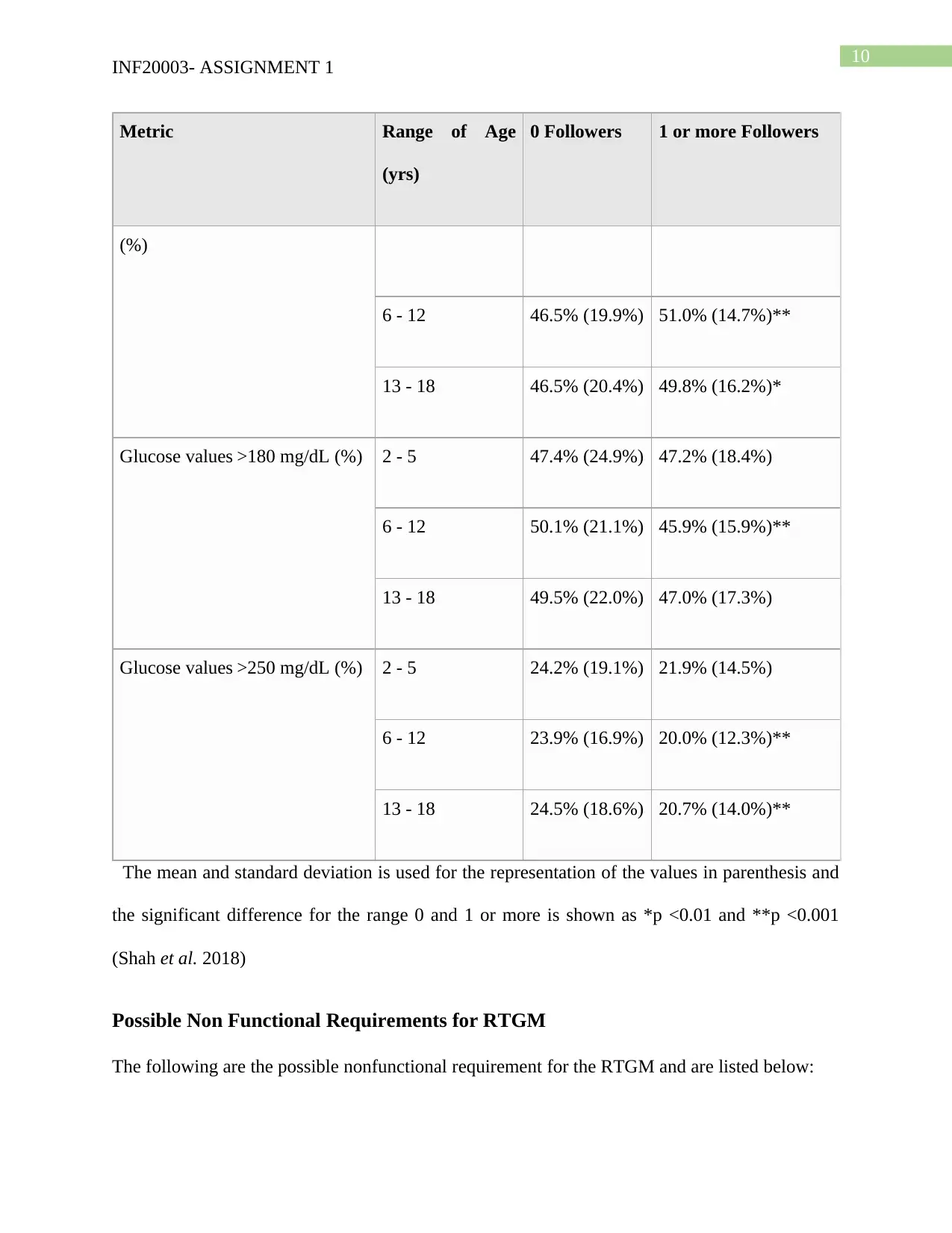
10
INF20003- ASSIGNMENT 1
Metric Range of Age
(yrs)
0 Followers 1 or more Followers
(%)
6 - 12 46.5% (19.9%) 51.0% (14.7%)**
13 - 18 46.5% (20.4%) 49.8% (16.2%)*
Glucose values >180 mg/dL (%) 2 - 5 47.4% (24.9%) 47.2% (18.4%)
6 - 12 50.1% (21.1%) 45.9% (15.9%)**
13 - 18 49.5% (22.0%) 47.0% (17.3%)
Glucose values >250 mg/dL (%) 2 - 5 24.2% (19.1%) 21.9% (14.5%)
6 - 12 23.9% (16.9%) 20.0% (12.3%)**
13 - 18 24.5% (18.6%) 20.7% (14.0%)**
The mean and standard deviation is used for the representation of the values in parenthesis and
the significant difference for the range 0 and 1 or more is shown as *p <0.01 and **p <0.001
(Shah et al. 2018)
Possible Non Functional Requirements for RTGM
The following are the possible nonfunctional requirement for the RTGM and are listed below:
INF20003- ASSIGNMENT 1
Metric Range of Age
(yrs)
0 Followers 1 or more Followers
(%)
6 - 12 46.5% (19.9%) 51.0% (14.7%)**
13 - 18 46.5% (20.4%) 49.8% (16.2%)*
Glucose values >180 mg/dL (%) 2 - 5 47.4% (24.9%) 47.2% (18.4%)
6 - 12 50.1% (21.1%) 45.9% (15.9%)**
13 - 18 49.5% (22.0%) 47.0% (17.3%)
Glucose values >250 mg/dL (%) 2 - 5 24.2% (19.1%) 21.9% (14.5%)
6 - 12 23.9% (16.9%) 20.0% (12.3%)**
13 - 18 24.5% (18.6%) 20.7% (14.0%)**
The mean and standard deviation is used for the representation of the values in parenthesis and
the significant difference for the range 0 and 1 or more is shown as *p <0.01 and **p <0.001
(Shah et al. 2018)
Possible Non Functional Requirements for RTGM
The following are the possible nonfunctional requirement for the RTGM and are listed below:
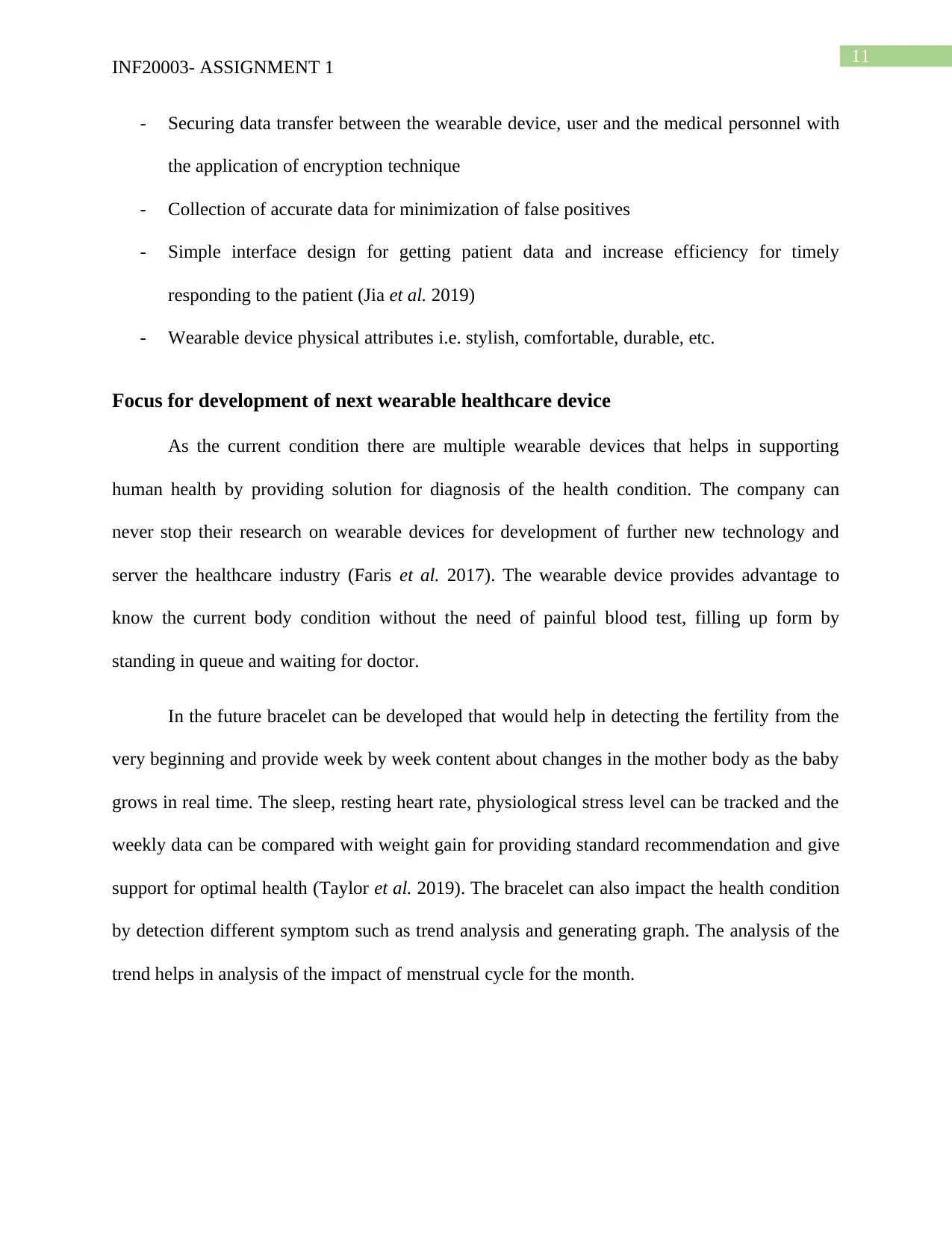
11
INF20003- ASSIGNMENT 1
- Securing data transfer between the wearable device, user and the medical personnel with
the application of encryption technique
- Collection of accurate data for minimization of false positives
- Simple interface design for getting patient data and increase efficiency for timely
responding to the patient (Jia et al. 2019)
- Wearable device physical attributes i.e. stylish, comfortable, durable, etc.
Focus for development of next wearable healthcare device
As the current condition there are multiple wearable devices that helps in supporting
human health by providing solution for diagnosis of the health condition. The company can
never stop their research on wearable devices for development of further new technology and
server the healthcare industry (Faris et al. 2017). The wearable device provides advantage to
know the current body condition without the need of painful blood test, filling up form by
standing in queue and waiting for doctor.
In the future bracelet can be developed that would help in detecting the fertility from the
very beginning and provide week by week content about changes in the mother body as the baby
grows in real time. The sleep, resting heart rate, physiological stress level can be tracked and the
weekly data can be compared with weight gain for providing standard recommendation and give
support for optimal health (Taylor et al. 2019). The bracelet can also impact the health condition
by detection different symptom such as trend analysis and generating graph. The analysis of the
trend helps in analysis of the impact of menstrual cycle for the month.
INF20003- ASSIGNMENT 1
- Securing data transfer between the wearable device, user and the medical personnel with
the application of encryption technique
- Collection of accurate data for minimization of false positives
- Simple interface design for getting patient data and increase efficiency for timely
responding to the patient (Jia et al. 2019)
- Wearable device physical attributes i.e. stylish, comfortable, durable, etc.
Focus for development of next wearable healthcare device
As the current condition there are multiple wearable devices that helps in supporting
human health by providing solution for diagnosis of the health condition. The company can
never stop their research on wearable devices for development of further new technology and
server the healthcare industry (Faris et al. 2017). The wearable device provides advantage to
know the current body condition without the need of painful blood test, filling up form by
standing in queue and waiting for doctor.
In the future bracelet can be developed that would help in detecting the fertility from the
very beginning and provide week by week content about changes in the mother body as the baby
grows in real time. The sleep, resting heart rate, physiological stress level can be tracked and the
weekly data can be compared with weight gain for providing standard recommendation and give
support for optimal health (Taylor et al. 2019). The bracelet can also impact the health condition
by detection different symptom such as trend analysis and generating graph. The analysis of the
trend helps in analysis of the impact of menstrual cycle for the month.
⊘ This is a preview!⊘
Do you want full access?
Subscribe today to unlock all pages.

Trusted by 1+ million students worldwide
1 out of 22
Related Documents
Your All-in-One AI-Powered Toolkit for Academic Success.
+13062052269
info@desklib.com
Available 24*7 on WhatsApp / Email
![[object Object]](/_next/static/media/star-bottom.7253800d.svg)
Unlock your academic potential
Copyright © 2020–2025 A2Z Services. All Rights Reserved. Developed and managed by ZUCOL.





